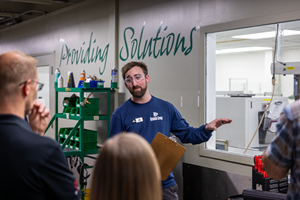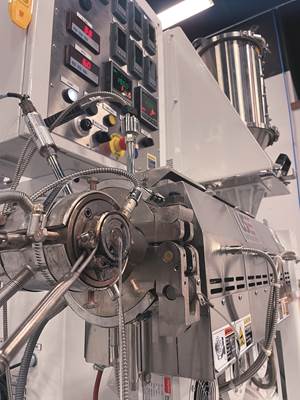nova-Institute's CEO Likes Plastics
“There are no other materials that have such a broad spectrum of properties,” says Michael Carus in an interview with Bio-based News editor.
A bright outlook on why plastics have a good future despite significant issues being faced by the industry was shared with us in this recent interview with Michael Carus, CEO of the German researcher nova-Institute and editor Svenja Geerken of the institute’s monthly newsletter, Bio-based News.
Carus, a physicist, founder and managing director of the nova-Institute, has been working for over 20 years in the field of bio- and CO2-based economy. The focus of his work is market analysis, techno-economic and ecological evaluation as well as the political and economic framework for bio-based processes and applications (“level playing field for industrial material use”). Considered to be one of the leading experts and market researchers in Europe on bio- and CO2-based economy and especially the industrial use of biomass, Carus is actively involved in building networks in the fields of agricultural and forestry resources, bio-based chemicals and materials (bio-based polymers, plastics and biocomposites) and industrial biotechnology and biorefinery. A member in many societies, associations and international organizations, Carus also serves as a consultant on policy in different countries in Europe, Asia and America.
Here are highlights of the interview including consumer perceptions, single-use bans, and strides that can be made by the industry:
Svenja: Currently, plastics are under great pressure. But you still seem to like plastics?
Michael: Absolutely. There are no other materials that have such a broad spectrum of properties and can be brought into any conceivable form with the greatest efficiency. In addition, plastics perform better than other materials under most sustainability criteria. This is due on the one hand to the high production efficiency already mentioned and, for example, to their low density with which they can score points in transport. In addition, product properties can often be achieved with much less material input.
Svenja: So everything is actually good and the current plastic hysteria lacks any basis?
Michael: Not at all! There are significant problems, but all of them can be solved and must be solved urgently. It is estimated that around 20% of the plastics produced worldwide end up in the environment uncontrolled, that is 60 million tonnes per year, of which around 8 million tonnes end up in the sea. The rest remains on land in soils, lakes and rivers. This is completely unacceptable. The other problem is the use of fossil carbon as a raw material that escapes into the atmosphere as CO2 at the end of life. This also has no future, the entire chemical industry must switch to renewable carbon, which can come from recycling, biomass or CO2.
Svenja: According to a recent survey, almost 80% of Germans consider plastics to be harmful rather than indispensable. Can we really solve these problems or should we not switch to other materials?
Michael: But to which ones? The reserves of metals are limited and mining often takes place under inhumane conditions. And minerals? Sand for cement is already becoming a scarce commodity worldwide. In the future, we will no longer be able to build our houses from reinforced concrete, as we do today, but rather from plastics. Because their raw material carbon is practically unlimited: As CO2 in the atmosphere, which we can make usable with the help of renewable energies or as biomass. That is enough raw material for the next millennia. This is the reason why plastics will gain in importance and the age of plastics has only just begun. And this is precisely why plastics must become sustainable as quickly as possible and regain a good image.
Svenja: And who bears the main blame for the whole dilemma?
Michael: The chemical and plastics industry, which has systematically tried to sweep problems under the carpet and sit out instead of actively pointing out and solving the problems. As one should expect from a crucial future industry!
Svenja: What are the mistakes that were made?
Michael: The microplastic problem has been well known for at least 10 years, which was when the Austrian documentary film “Plastic Planet” was first shown. But the industry acts according to the motto: ignore it, do not talk or write about it, just sit out the problem. The considerable quantities of plastic waste, which are also released into the environment in an uncontrolled manner in the European Union, are systematically missing from the plastic statistics. For decades, bans on hormone-active plasticizers were prevented. Eyes were closed on the large-volume plastic waste exports to developing countries, which count as material recycling. Every expert knew what really happened to the plastics.
In the European Union, less than 10% of waste plastics are recycled into new plastics. Thermoplastics can be recycled very well if collected in their pure form, better than most other materials. Instead of tackling the actual problems, it was perceived only as “communication problems”. And when the plastics industry is asleep, they should not be surprised if the EU Commission and the national environment ministries now take matters into their own hands. The recently adopted plastics strategy, including restrictions and bans on certain disposable plastic products, is the consequence of this behavior.
Svenja: And are politics doing better than the industry now in tackling the problem?
Michael: I’m afraid not. Of course, there are some sensible measures being taken, such as the ban on oxo-degradable plastics, which decompose particularly quickly into microplastics. However, the “single-use ban” is a purely symbolic policy and a bad one at that, which will have little effect, but will heat up the plastic hysteria, pronounce unnecessary product bans and leave the field to worse materials—without affecting the real problems at all!
There would be a number of measures that would make a real difference on a large scale: Plastic waste export bans, landfill bans, mandatory deposit for all plastic bottles for all types of beverages, a ban on the intentional use of microplastics and increased use of high-quality polymers instead of composite systems, as these are easier to recycle (Design for Recycling). Plastic waste could be systematically collected and recycled worldwide. A global standard for the biodegradation of certain polymers could reduce risks in case that leakage into the environment is unavoidable.
And finally, a clear concept is needed on how to move from fossil to renewable carbon by 2050. Or would the plastics industry like to be pilloried in 2050 as one of the largest and last emitters of fossil carbon? As an industry of the future? A photovoltaic area of only 1% of that of the Sahara would suffice to supply the entire chemical industry with renewable carbon – via solar hydrogen and CO2 from the air.
Svenja: What is so bad about the single-use ban, aren’t many products really pointless or can they be better substituted by other materials?
Michael: What is worse about a coffee plastic stirrer than a wooden stirrer if it is properly rinsed or disposed of? Nothing. On the contrary. Due to its efficient production, the plastic stirrer should have a lower carbon footprint and can be materially recycled. The plastic stirrer can thus be turned into a plastic stirrer again. This will not be possible with the wood stirrer – unless plastic helps to bind the wood particles. This is just one example among many.
If one does not want to switch to ecologically worse materials, the single-use ban of plastics is practically equivalent to product bans. Do we want an eco-dictatorship? A race for bans? One person thinks straws, the other balloon holder or coffee capsules are unnecessary – in the end we will all miss many products. Wouldn’t it make more sense to respect the needs of the people and find the best materials and end-of-life options that have the least environmental impact?
In many cases, these are already plastics today – whether PET bottles, shopping bags or packaging that protect food – and all the more this will be the case for future plastics based on renewable carbon, either from mechanical and chemical recycling, biomass or direct CO2 use.
The single-use ban fuels the plastic hysteria, but it’s not plastics we should do without. The aim is to quickly turn plastics into a truly sustainable material solution and set up comprehensive disposal and recycling systems that minimize the risk of plastics entering the environment and causing microparticles. Given the raw material situation, we have no other option. And consumers will learn that more sustainable plastics will be more expensive, but already today almost half of German consumers are willing to spend more money on sustainable products.
Svenja: And this will succeed?
Michael: I’m an optimist. The plastics industry can emerge from the current crisis new and strengthened like the Phoenix from the ashes – if it now does its homework and consistently tackles and solves the problems, and finally understands that they are not communication problems!
In the meantime, the first, long overdue steps have been taken: around 30 leading chemical companies that operate along the value chain worldwide have organized themselves in the “Alliance to End Plastic Waste (AEPW)” and intend to invest around 1.5 billion dollars over the next five years to promote projects for waste management, the circular economy and new recycling technologies. Manufacturers of consumer products are finally beginning to produce their packaging from 100% recycled material and make it fully recyclable.
The targeted collection of plastic waste is also starting with its first projects. In Haiti, for example, the inhabitants collect plastic waste, and this year the amount is expected to reach 300 tonnes. In return, Henkel provides benefits in kind such as charcoal for cooking, vouchers for children attending school and the opportunity to recharge their mobile phones, or simply cash. A good idea to buy collected plastic waste as a raw material. That should set a precedent all over the world.
Related Content
Allegheny Performance Plastics to Enter Health Care Sector
The custom molder has secured multiple projects in health care and will be adding cleanroom and white-room spaces, as well as injection molding machines, in support.
Read MoreUse Cavity Pressure Measurement to Simplify GMP-Compliant Medical Molding
Cavity-pressure monitoring describes precisely what’s taking place inside the mold, providing a transparent view of the conditions under which a part is created and ensuring conformance with GMP and ISO 13485 in medical injection molding.
Read MoreMedical Molder, Moldmaker Embraces Continuous Improvement
True to the adjective in its name, Dynamic Group has been characterized by constant change, activity and progress over its nearly five decades as a medical molder and moldmaker.
Read MoreCatheter Specialist Finds Sweet Spot Serving Small, Medium-Sized Concerns
Medical-component specialist LightningCath has carved a niche meeting the needs of small to medium-sized entrepreneurs with complex catheter designs … quickly.
Read MoreRead Next
Beyond Prototypes: 8 Ways the Plastics Industry Is Using 3D Printing
Plastics processors are finding applications for 3D printing around the plant and across the supply chain. Here are 8 examples to look for at NPE2024.
Read MoreLead the Conversation, Change the Conversation
Coverage of single-use plastics can be both misleading and demoralizing. Here are 10 tips for changing the perception of the plastics industry at your company and in your community.
Read More



























